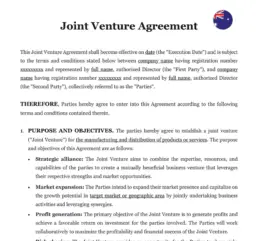Understanding Business Collaboration in Australia
A Joint Venture Agreement is crucial when entering a business collaboration. It outlines the responsibilities, contributions, and profit-sharing arrangements between the parties involved. This agreement serves as the backbone of the collaboration, ensuring that all partners are clear on their roles and the expectations placed upon them.
Without a Joint Venture Agreement, misunderstandings can arise, potentially leading to disputes or even the collapse of the collaboration. For businesses seeking to protect their interests, having this agreement in place is essential.
Defining Roles and Responsibilities
The success of a business collaboration depends heavily on clearly defined roles and responsibilities.
1. Role Allocation: Determine who is responsible for what within the business collaboration. This might include specific tasks, management roles, or decision-making authority.
2. Contributions: Outline the contributions each party will make, whether financial, intellectual property, or labor-related.
3. Decision-Making Process: Establish how decisions will be made within the venture. Will it be a majority vote, consensus, or will certain decisions require unanimous agreement?
Defining roles and responsibilities in a business collaboration ensures that all parties understand their obligations, reducing the likelihood of conflicts.
Structuring Profit Sharing and Loss Allocation
A critical aspect of any business collaboration is how profits and losses will be shared.
1. Profit Sharing: Specify how profits will be distributed among the partners. This could be based on contributions, ownership percentages, or other agreed-upon criteria.
2. Loss Allocation: Similarly, determine how losses will be allocated. This ensures that all parties are prepared for potential financial downturns.
3. Payment Schedule: Decide on a payment schedule for profit distributions, whether it’s monthly, quarterly, or annually.
The profit-sharing and loss allocation terms are pivotal to the financial health of the business collaboration. For more on structuring profit-sharing arrangements, see our article on Legal Agreements for Sharing Business Profits.
Protecting Intellectual Property and Confidentiality
Intellectual property (IP) is often a key asset in business collaborations, and protecting it is vital.
1. IP Ownership: Determine who owns the intellectual property contributed to the business collaboration. This includes patents, trademarks, copyrights, and trade secrets.
2. IP Use: Specify how the intellectual property can be used within the venture and by the partners after the venture ends.
3. Confidentiality Clauses: Include confidentiality clauses to protect sensitive information. This prevents unauthorized use or disclosure of proprietary information
Planning for Dispute Resolution
Even with the best intentions, disputes can arise in any business collaboration.
| ➤ Mediation: Include a clause requiring mediation as the first step in resolving disputes. Mediation is a less formal and often quicker way to resolve conflicts. |
| ➤ Arbitration: If mediation fails, arbitration provides a binding resolution without the need for court intervention. Specify the arbitration process and governing law in the agreement. |
| ➤ Litigation: As a last resort, litigation may be necessary. Ensure the agreement specifies the jurisdiction and court where any legal actions will be taken. |











